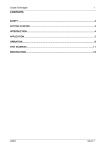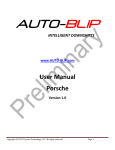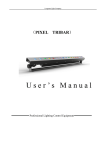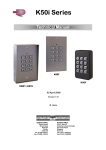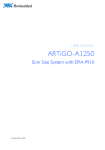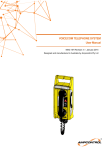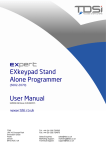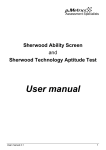Download Manual - Crucible Technologies
Transcript
CRUCIBLE TECHNOLOGIES 1 CONTENTS SAFETY ................................................................ ................................................................................................ ............................................................................ ............................................2 ............ 2 GETTING STARTED ................................................................ ........................................................................................... ...........................................................3 ........................... 3 INTRODUCTION................................ INTRODUCTION ................................................................ ................................................................................................ ................................................................4 ................................ 4 APPLICATION ................................................................ ................................................................................................ ................................................................... ...................................5 ... 5 OPERATION ................................................................ ................................................................................................ ...................................................................... ......................................7 ...... 7 TEST EXAMPLES ................................................................ .............................................................................................. ..............................................................12 .............................. 12 SPECIFICATION ................................................................ ............................................................................................... ...............................................................18 ............................... 18 Testel 100E Issue 3.2 CRUCIBLE TECHNOLOGIES 2 SAFETY Read this manual completely before using the instrument. 1. The TESTEL 100E is designed to behave like an exchange line therefore only telecommunication apparatus designed to connect to telephone lines must be connected to it. 2. Under no circumstances must the TESTEL 100E be connected to the Public Switched Telephone Network (PSTN) or any PABX extension ports. 3. When using the TESTEL 100E to test the performance of unapproved telecommunication apparatus, due consideration must be paid to any hazard involved. 4. WARNING The connection sockets have high voltages present during Ringing and Pulse dialling. Although this is not hazardous, it can be painful. 5. The unit is designed to be powered from a 230 V, 50 Hz source. The IEC Power Lead provided is fitted with a 5 Amp fused mains plug. 6. The Mains Switch at the IEC Socket needs to be in the Off position to isolate the unit from the mains. 7. There are no user serviceable parts in this unit. Under no circumstances should the user attempt to open the unit. If opened, the warranty will be invalidated. 8. Your Crucible Technologies product is guaranteed for one year from the date of purchase. Please keep your invoice as proof of purchase. Should a problem arise with the product, please contact; [email protected] for technical assistance. If you wish to return your product please contact; [email protected] to receive a returns authorisation number, and instructions for returning the product. You will be advised of costs prior to any work commencing. This guarantee does not affect your statutory rights.. Testel 100E Issue 3.2 CRUCIBLE TECHNOLOGIES 3 GETTING STARTED Before using the TESTEL 100E, please check that the following items have been included in the shipment: • TESTEL 100E Unit • IEC Power Lead • 2 x RJ11 Converters • User Manual Check for damage in transit. If there is any sign of damage, please report it to your supplier and do not attempt to repair the unit. The unit is factory set to be powered from a 230 V supply. This is indicated on the rating plate. (If a 110 V unit has been supplied, the rating plate will indicate this). Please ensure that this product is powered from the correct source. The apparatus is CLASS II double insulated construction, so does not require a protective earth connection. UNDER NO CIRCUMSTANCES SHOULD THIS PRODUCT BE CONNECTED TO THE PSTN Testel 100E Issue 3.2 CRUCIBLE TECHNOLOGIES 4 INTRODUCTION The TESTEL 100E is designed to help in the testing of a wide range of telecommunication apparatus. Its features make it an invaluable tool in design laboratories, service centres and small-scale production facilities. The TESTEL 100E provides an accurate simulation of telephone lines. The feed voltage applied to the Unit Under Test (UUT) is 48 V and the ring voltage is 80 V, 25 Hz near sinusoid signal with DC backing. This ensures that telecommunication apparatus that work on the TESTEL 100E are sure to work on real telephone lines. It is useful for engineers who need to test products. However, the controls are straightforward to use which makes it ideal for non-technical personnel. Testel 100E Issue 3.2 CRUCIBLE TECHNOLOGIES 5 APPLICATION There are a wide variety of applications for TESTEL 100E, some of which are listed below: FAULT ANALYSIS The TESTEL 100E is useful for checking returns from customers to make sure the fault lies with the returned product and not with the user. Non-technical staff are able to check a telephone, answering machine or fax, just by connecting it to the TESTEL 100E and carrying out tests, as one would do if using a normal phone line. In less than a minute, tests such as Off-hook, dialling, handset operation and ringing can be completed. The TESTEL 100E provides many benefits over using a telephone line for testing. All the dialled digits can be checked and not just the digits needed to route a call. One person can carry out complete testing as ringing starts at the push of a button. No call costs are involved. REPAIR The TESTEL 100E provides a telephone line on every technician’s workbench. This allows products to be checked as repairs are carried out. On completion of the repair, the telephone apparatus can be fully checked including operation with both polarity and line current. PRODUCTION The TESTEL 100E can be used for production testing of many telecommunication products. Features such as digit timings, signal level (displayed on the bar graph) and adjustable ring level, will allow the test engineer to build the TESTEL 100E into a production test procedure. Testel 100E Issue 3.2 CRUCIBLE TECHNOLOGIES 6 OPERATION SUPPLY The unit is designed to be powered from the mains 230 V, 50 Hz using the IEC lead supplied. Connect to the IEC socket at the rear of the unit and switch on. The Power LED will light signifying that power is being supplied to the unit. MASTER SOCKET When the unit plugged into the Master Socket (referred to as Master) seizes the line, the Line Looped LED comes on. If ringing was present, this is stopped. The ring trip operates during the quiet periods of the cadence. There is no ring trip when the continuous ring option is chosen. The polarity and current applied to the Master is dependent on the relevant switch positions. If there is any speech or tone on the line its level is displayed on the bar graph. When positive polarity is selected A is positive with respect to B. This is reversed when the negative polarity is selected. The S terminal is connected to the B terminal through a 1.8 µF capacitor. The E terminal is used for detecting the Earth Recall signal. The pin configuration on the socket is representative of a standard phone socket on the wall and is as follows: NOTE: A ⇒ Pin 2 B ⇒ Pin 5 E ⇒ Pin 3 S ⇒ Pin 4 There are also four 4mm sockets supplied, connected to A, B, E and S. These are useful for connection of measurement apparatus or adaptors. Testel 100E Issue 3.2 CRUCIBLE TECHNOLOGIES 7 RINGING The user can select the cadence and level of the ringing. A PSTN or PBX type cadence can be selected. Alternatively, the ringing can be applied continuously. The level can be set to High or Low or to a user pre-selected one. This is done by adjusting a multi-turn pot at the rear of the unit, until the required level is obtained. Once selected, the ringing can be applied to the Master by operating the Start/Stop button. The ringing is terminated, either by the Master seizing the line or by operating the Start/Stop button. The same ringing cadence and level is applied to the Extension when the Master dials 159. In this case, the ringing stops either when the Extension seizes the line or when the Master goes On-hook. No ring trip is provided on continuous ring option. When the Extension is rung by keying in 159, Ring Back tone at the selected cadence is fed back to the unit plugged into the Master socket. The Extension can dial the Master by dialling 159. DIALLING The digits dialled by the UUT are shown on the 8 digit LCD. The digits can be Pulse, Tone or both; the Tone digits are shown with a dot underneath to differentiate them from the Pulse digits. The timing limit on the Make and Break of Pulse dialling are set carefully, to detect any problem that may exist. The level of tones is displayed on the Bar Graph. A Timed Break Recall (TBR) signal is either displayed as a Pulse digit 1 or R depending on its timing. If the break time is less than 80 mS then a Pulse digit 1 is displayed. If break is greater than 80 mS then an R is displayed. This way the time limits for Pulse break are not compromised. An Earth Recall is shown as an E on the LCD display. Testel 100E Issue 3.2 CRUCIBLE TECHNOLOGIES 8 When more than 8 digits are dialled and there is a pause of more than 5 seconds the display starts to scroll all the digits dialled. A maximum of 64 digits can be detected and displayed. When the UUT is On-line, pressing the Start/Stop button can freeze the scrolling display. In the frozen mode the display flashes. The freeze can be terminated by the operation of the Start/Stop button or by dialling a digit. (Note: The display freeze only works in the On-line mode, as in the Off-line mode, the Start/Stop button is used to start the ringing). The scrolling of the display carries on in the Off-line mode. BAR GRAPH This displays the level of signals (tone or speech) at the Master socket interface. For signals generated by the TESTEL 100E or the Extension, the Bar Graph will be affected by the Attenuator Switch position, for example it will give the true level at the Master. For signals generated by the Master (eg speech/tones) the level displayed is not affected by the Attenuator. However, the Attenuator affects the level presented to the TESTEL 100E or to the Extension. ATTENUATOR This is used to attenuate signals to and from the Master. When the Extension is On-hook then the Attenuator controls the level of test tones applied to the Master. Also tone signals originating from the Master are controlled by the Attenuator before being detected. When the Extension is Off-hook signals between it and the Master are affected by the Attenuator position. EXTENSION SOCKET The Extension can be rung from the Master by dialling 159 (Pulse, Tone or mixed). The parameters of the ringing applied are as set on the ring control section. The ringing stops either when the Extension comes Off-hook or the Master goes On-hook. Testel 100E Issue 3.2 CRUCIBLE TECHNOLOGIES 9 The Attenuator Switch controls the attenuation to speech or signals between the Master and Extension. This can be set to 0, 10 or 30 dB of attenuation. Whenever the Extension seizes the line a speech path is set up between it and the Master. NOTE: There are two 4mm sockets supplied connected to A and B. These are useful for connection of measurement apparatus or adapters. Testel 100E Issue 3.2 CRUCIBLE TECHNOLOGIES 10 PULSE DIAL TIMINGS Pulse dial Make/Break/IDP timings can be brought up on the display by dialling 200 after seizing the line. The displayed Make/Break timings are based on the last digit dialled and the IDP based on the last two digits dialled. Further digits (Pulse or Tone) can be timed by dialling these after 200. The display will automatically update to show the Make/Break timings of the last digit dialled and the IDP between the last two digits. TONE DIAL TIMINGS Tone dialling On/Off times can be displayed by entering 200 after seizing the line. On timings are based on the last digit dialled whilst Off timings are based on the pause between last two digits dialled. Further digits (Pulse or Tone) can be timed by entering these after dialling 200. PULSE DIAL TIMING CHECK During Pulse dialling, if the following timing errors are detected, an error message is flashed on the display. MAKE TIMINGS BREAK TIMINGS Limits 33.3 mS ± 30% Low timing gives an error High timing gives an error Limits 66.6 mS ± 30% Low timing gives an error High timing gives an error MKE<23 mS MKE>43 mS MKE<46 mS MKE>86 mS Transients of less than 5 mS duration are ignored. The error message will time out after 5 seconds. However, if a valid digit is detected or another error message is to be displayed, the original message will be overwritten. Testel 100E Issue 3.2 CRUCIBLE TECHNOLOGIES 11 DIAL UP SUPERVISORY TONES Various supervisory tones can be dialled up by keying in specific codes from the unit plugged into the Master socket. These are given below: 300 ⇒ RING BACK TONE 301 ⇒ PAY TONE 302 ⇒ ENGAGED TONE 303 ⇒ PATH ENGAGED (PARK) TONE 304 ⇒ NUMBER UNOBTAINABLE 147 ⇒ RING BACK NOTE 1: The frequency for all the above tones is set to 425 Hz NOTE 2: A couple of self-test features are provided. 100 ⇒ GIVES ISSUE OF SOFTWARE 999 ⇒ TESTS LCD Testel 100E Issue 3.2 CRUCIBLE TECHNOLOGIES 12 TEST EXAMPLES FUNCTIONAL TEST OF TELEPHONES START PLUG UNIT IN AND LIFT HANDSET FAULTY HOOK SWITCH NO LINE LOOPED LED ON? YES HEAR DIAL TONE? NO HANDSET RECEIVER FAULTY NO HANDSET MICROPHONE FAULTY NO KEYPAD FAULTY NO RINGER FAULTY YES SPEAK INTO HANDSET, SPEECH ON BAR GRAPH? YES DIAL 1, 2, 3…9, 0 SEE DIGITS ON DISPLAY? YES REPLACE HANDSET CHECK IF RINGER IS ON OPERATE RING ON/OFF SWITCH TELEPHONE RINGING? YES PASS Testel 100E Issue 3.2 CRUCIBLE TECHNOLOGIES 13 RING DETECT SENSITIVITY ON AUTOAUTO-ANSWER APPARATUS START SET UNIT NOT TO ANSWER. PLUG INTO TESTEL 100E HOLD RING SWITCH DOWN AND POWER ON TO GET CONTINUOUS RINGING CONNECT DVM TO 4 mm TERMINALS A and B ADJUST RING LEVEL CONTROL TO GET REQUIRED LEVEL (eg 20 V rms) TURN RINGING OFF. SELECT PSTN CADENCE OPERATE RING SWITCH TO START RINGING PASS Testel 100E YES UNIT AUTO-ANSWERS? NO FAIL Issue 3.2 CRUCIBLE TECHNOLOGIES 14 ANSWERING MACHINE CLEARDOWN TO SILENCE START PLUG UNIT IN TO TESTEL 100E CONNECT TELEPHONE TO EXTENSION SOCKET, DIAL 159 WAIT FOR UNIT TO ANSWER LISTEN TO OUT GOING MESSAGE LEAVE A MESSAGE PRESS MUTE BUTTON ON EXTENSION TELEPHONE PASS Testel 100E YES ANSWERING MACHINE DROPS LINE IN 6 SECONDS? NO FAIL Issue 3.2 CRUCIBLE TECHNOLOGIES 15 ANSWERING ANSWERING MACHINE CLEARDOWN TO EXTENSION PHONE PICK UP START PLUG UNIT INTO TESTEL 100E AND USING A DOUBLER, PLUG IN A NORMAL TELEPHONE IN PARALLEL OPERATE RING SWITCH WAIT FOR UNIT TO AUTO-ANSWER DURING THE PLAYING OF THE OUTGOING MESSAGE, PICK UP THE TELEPHONE PASS Testel 100E YES ANSWERING MACHINE DROPS THE LINE IMMEDIATELY? NO FAIL Issue 3.2 CRUCIBLE TECHNOLOGIES 16 ANSWERING MACHINE REMOTE INTERROGATION START PLUG UNIT INTO TESTEL 100E, SET ATT TO –10 dB CONNECT TELEPHONE TO EXTENSION SOCKET DIAL 159 WAIT FOR UNIT TO AUTO-ANSWER ENTER REMOTE INTERROGATION CODE PASS Testel 100E YES ANSWERING MACHINE ALLOWS REMOTE INTERROGATION NO FAIL Issue 3.2 CRUCIBLE TECHNOLOGIES 17 MODEM TEST START CONNECT TEST MODEM TO MASTER SOCKET CONNECT REFERENCE MODEM TO EXTENSION STOCK SET ATT. TO 10 dB CHECK COMMUNICATION NO FAIL NO CHECK MODEM SPECIFICATION YES CLEAR DOWN SET ATT. TO 30 dB CHECK COMMUNICATION YES PASS Testel 100E Issue 3.2 CRUCIBLE TECHNOLOGIES 18 SPECIFICATION MASTER SOCKET DC Voltage Feed Bridge DC Resistance 48 V ± 5% 2 x 200 Ω ± 5% 180 Ω ± 10% (= 1 km line) 1380 Ω ± 10% (= 7.5 km line) EXTENSION SOCKET Voltage S/C Current 48 V ± 5%. 40 mA ± 10%. DIAL TONE Frequency Level: 425 Hz -6, -16 or –36 dBm Voltage High Voltage Low Cadence 80 V ± 10% rms 40 V ± 10% rms Adjustable from 0 V to 95 V rms 25 Hz AC (near sinusoid), DC backed PSTN, PBX or Continuous PULSE DIALLING Make Break IDP On-Hook Off-Hook TBR 25-41 mS 50-82 mS >200 mS >300 mS >200 mS 80-110 mS TONE DIALLING Tone Time Accept Frequency Reject Frequency >40 mS ± 1.5% ± 3.5% RINGING User Level Frequency Type ATTENUATION BAR GRAPH To and from Master Socket 0, 10 or 30 dB Attenuation Range Top LED centred on –1 dBm ± 1 dB Ten LEDs each 3 dB ± 1 dB 0 to 30 dB TOLERANCE unless otherwise specified Frequency Timing Level ± 10% ± 10% ± 3 dB POWER Mains 230 V, 50 Hz, 50 mA Testel 100E Reference Issue 3.2


















